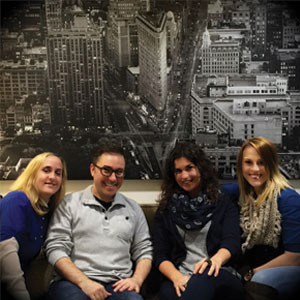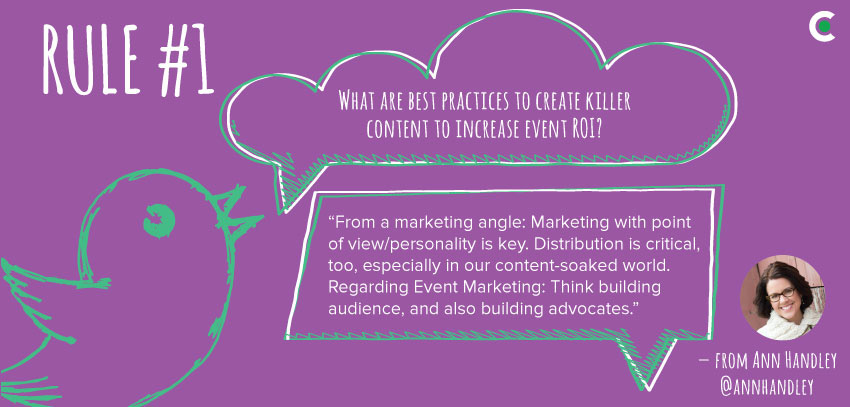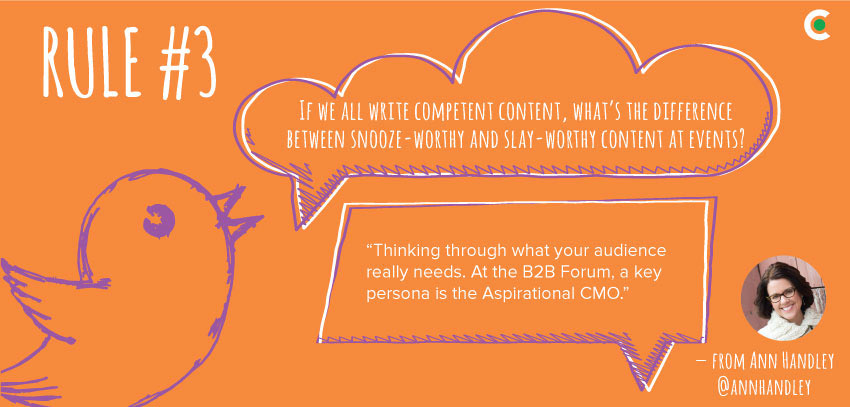Ann Handley threw it down at Certain’s first Twitter Chat #MKTGPOV: How to Slay Event Mediocrity with Killer Content with our Director of Marketing Communications, Lynn Langmade. Thank you to everyone who participated! We cut our teeth learning about the best practices for slay-worthy content to increase event ROI, tips on how to create engaging sessions, and what to avoid at all costs at an event. #HowToAvoidEventMarketingDisasters
If you missed our chat, never fear, Storify is here! You can review our entire Twitter Chat at the end of this post, and learn what you can be doing to enhance your event content strategy.

Want to know our top four takeaways, and what the #MKTGPOV Twitter Chat Team learned from Ann Handley? Here is a compilation of our four favorite tips from Ann, which can serve as cardinal rules of event content strategy: an event marketer’s True North, if you will, which include our own insights.
Think of this as a monthly column with actionable tips to generate leads from events and create content that engages your audience. #BringOnTheKillerContent
Here’s a look at the #MKTGPOV Twitter Chat Team who will be responding with our takeaways:

Lynn Langmade (LL): Dir. Marketing Communications
Kent Martin (KM): Social Media Specialist
Michelle Threadgould (MT): Senior Copywriter
Taylor Tomlin (TT): Graphic Designer

MT: Lynn, our Director of Marketing Communications has said events are content. In Ann’s quote, she shows us that it’s not just the content that we create at the event that is important: it’s how we follow-up, the way the content influences customer experience, and the impression that your content/event leaves on your audience.
That is literally what your attendees will be walking away with. So understanding your audience, targeting and segmenting your sessions, and building brand advocates will increase event ROI, and effectively stop events from being a cost-center, and instead, a lead generator.
KM: The personality around our marketing efforts is driven by our customer base. I think about the savvy, data-driven marketers that are interested in Certain’s event platform and how we provide them with the tools they need to arm themselves with as much material as possible to have successful events that generate lots of new customers for their brands.
Ann’s words remind me to constantly ask myself what I can contribute that will be of value to our customers. Data will provide us with plenty of information and guidance, but the ways that we communicate through our event marketing should keep our humanity intact.
Also, no one wants to feel like part of a cattle herd at large events, and we are finding ways that technology can provide marketers with information that will make events feel more personal and welcoming for all of their attendees.
TT: Graphic designers are faced with the challenge of designing with a point of view and personality daily. We all know that visual content is critical to a successful marketing campaign, and with that said, that means we need some killer graphics to accompany that killer content.
People are much more likely to connect with information when it is designed with a purpose and has that oh so important personality. Our brains process visuals 60,000 times faster than text, so make sure that the visuals rocks! Our jobs as designers is to take a content marketer’s words and bring them to life with graphics.
If you can develop a synergy between a content marketer and a graphic designer, your marketing efforts will go a long way.
MT: When you pitch from the podium, you isolate your audience from you and you reveal how out of touch you are to their needs, while also showing your audience that when you look at them, all you see is dollar signs, not people (which ironically, negatively affects your bottom line).
I could not agree more with Ann’s suggestion to ban pay to play, because it is the only way to ensure quality sessions with top industry influencers who are providing us with best practices and actionable takeaways.
KM: I have seen many awkward panel presentations with panelists heads turning over silences, punctuated by throat-clearing, until someone decides to tackle a question. With regards to pitching at the podium, I recall Ann’s point about asking myself “will my audience thank me for this?” With both content and events, it’s crucial to design a valuable experience for the audience, and as a result they ‘thank you’ by becoming advocates.
TT: Oh boy, the thing that comes to mind here is the typical PowerPoint presentation and how to avoid the dreaded clip-art and novel length sentences. Don’t get me wrong, PowerPoints can be an awesome tool, but usually they go two ways: either contribute to a presenter’s awesome keynote or put the unengaged audience to sleep.
One of the easiest tips I can provide on this is to consider text; ensure that you are not putting your word-for-word speech on a slide. If you do this, your audience is guaranteed to read through the entire slide on their own, without actually listening to you speak those same words.
You have lost your audience and honestly might be better off just sitting down and flipping silently through your slides. Doesn’t sound all that engaging does it? To avoid this content disaster, I recommend you ask yourself what are the most important goals for their presentation.
What are the key points for each slide? Do you have any interesting facts or quotes that could accompany the words you have to say? With these little nuggets of content, you can create engaging slides that will add to the presentation, versus take away from it and I promise your audience will thank you greatly for that.
MT: This answer really hones in on the psychology of good marketing. We are all the “aspirational CMO,” as in, we always want to follow advice that enables us to become who we aspire to be.
When it comes to writing well, you have a lot of competition. Think about all of the kids who were the smartest and best writers in English class in high school, now think about those kids at the top of their class in college, now aggregate all of those top performers, and have them producing top-quality content.
There are thousands of people producing quality content every day. A bleak way of looking at it is: if you’re smart, creative, forward-thinking, well-read, and a good writer— get in line.
So, writing well is not enough.
You have to think of what your audience wants to hear at events, without pandering. You need to create innovative solutions or elegant ways to present information that your audience may have heard before, but present it in a different light. To do this, you have to think about the gap that your audience is currently experiencing, between who they are and where they want to be.
This is why I found Ann’s answer about the “aspirational CMO” to be so important, it requires all of us to think of how our content can directly address our audience’s concerns, and give them content that enables them to create their own paradigm shift.
KM: “Aspirational CMOs” is brilliant! Most of us want to feel like we are growing in our careers (not to mention our personal lives, but who has time for that? ;)). Ann writes a lot about empathising with the audience and offering them a depth of interaction that they aren’t getting elsewhere.
Another thing she mentioned in our chat was the significance of building surprises into the event programming. Organizers may have the best intentions, but if they’re doing the same things over and over, it can become rote for audiences the second or third time around.
TT: Here, I echo Michelle’s sentiment that writing is not enough. You can have slay-worthy content turn snooze-worthy in the blink of an eye from a graphic perspective. As I said earlier, it’s a designer’s job to take a content marketer’s words and bring them to life with visuals. At events, the visuals are especially critical to engagement.
You want that wow-factor when someone walks over to your booth, sits in your keynote or grabs a handout/brochure. This is where audience comes in, and I can’t agree with Ann any more when she shares that we must think through what our audience needs and what they might like to see.
MT: “Words are your currency” needs to be my new marketing motto, and it really reflects a current shift in the way that we look at how our messaging, social media, and the content we use to attract qualified leads and prospects. By now, as marketers, we’ve accepted that all of the words that we put out into the universe are part of “our brand.”
But to take this line of thinking a step farther, what content do we need to be generating to get our audience to “buy-in” to us, our brand, and the companies we represent? So “your currency” becomes synonymous with “your reputation.” That means that if your words/brand are identified with engaging, informative, and creative content, you become the marketer/thinker/product that your audience trusts and wants to “invest” in.
Ann’s answer illustrates that words are more than a vehicle of communication, words are your cultural currency and what ultimately make you valuable.
KM: I like Ann’s other quote, “The truth is this: writing well is part habit, part knowledge of some fundamental rules, and part giving a damn.” That sums up her book pretty well, too. I think I’ll make that MY motto. Yes dammit, I DO give a damn. When we ‘regard publishing as a privilege’ as she says in Everybody Writes, we are creating content from a place of respect for our audience.
In the rush of our day to day pressures to publish across zillions of channels, it’s easy to fall into mechanical, dry communications just to whittle our to-do list down. Ann reminds me to think carefully about every word I type on our social channels. She says to focus on growing our audience in one channel first before sprinting to the next, shiny platform.
Consistency is essential. And all of this applies to event marketing too. It may take more time to be thoughtful, but our audience and customers will appreciate it.
TT: Push for your designer to be included in the development of content with the marketing team. They have ideas too and have a unique perspective on how to make those words pop on a page. Having a number of people with different expertise allows for a richer brainstorm and development process.
With a designer in the room, a visual perspective is offered that could take a sentence of great content and turn it into an awesome two word graphic campaign. If you create a space where all ideas are welcomed, you may be surprised by what materializes during a brainstorming session. That content just might turn into slay-worthy content and add even more currency to your brand!



